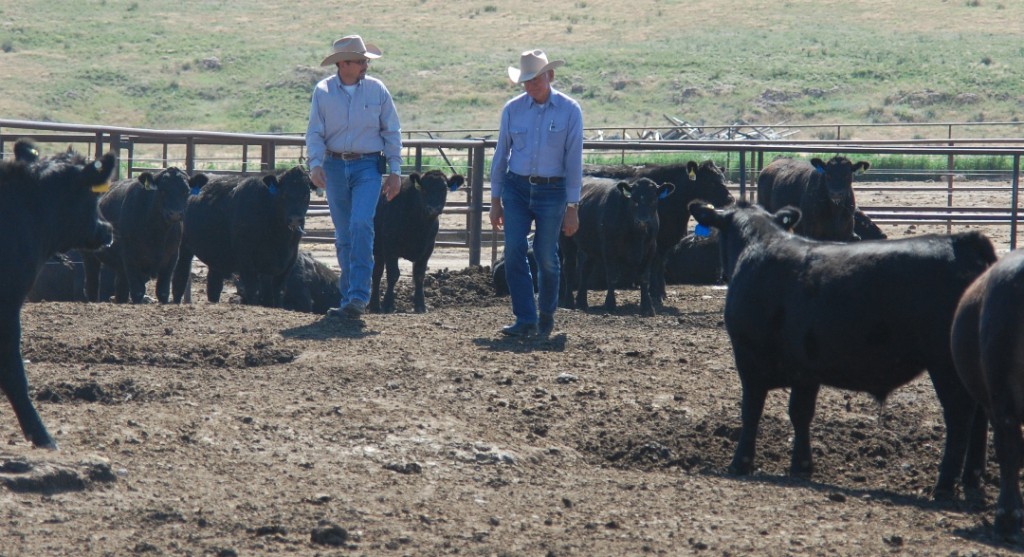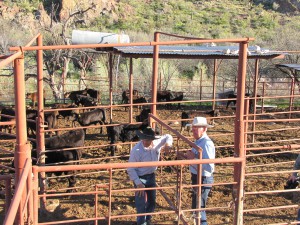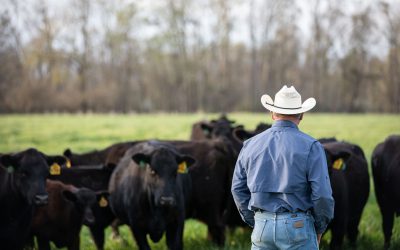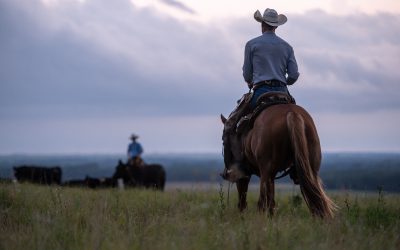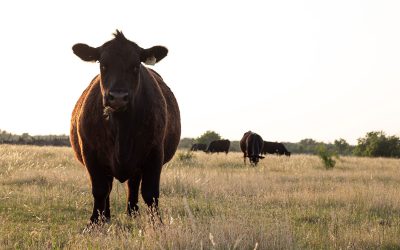Following the Calves: Gearing up for Spring in AZ
Spring comes early in the deserts of California and Arizona. You may have seen the pictures of a rare floral bloom in Death Valley last month.
On the Quarter Circle U Ranch in the Superstition Mountains east of Phoenix, Angus calves were up before the flowers. By March they were munching on opportunity grasses next to their mamas, who show by example what is safe to eat.
Today, they’re all in the central pens for branding and AI (artificial insemination for the 168 mamas) as family and friends on horseback gathered the herd this week. That’s daughter Amy Doyle with Chuck in the lead photo above.
Eighty-eight replacement heifers, sisters from last year chosen with the help of genomic test results, are in a developing paddock a couple of miles away. “They are there to mature rather than gain more weight,” Chuck says. And they will soon get their turn for AI to a standout sire for calving ease and efficiency.
But 30 cull heifers and 119 steers made the 850-mile trip to Oklahoma in December.
Ranch owner-manager Chuck Backus sent an email to his feeding partner at Cattleman’s Choice Feed Yard, near Gage, Okla., shortly after those loads hit the trail:
“Dale [Moore],
The two trucks left the ranch at 1 PM, AZ time (MST). They should probably arrive at the Feedyard about 8 AM [Dec. 16]. All of the inspection papers and certificates are in the envelope with them.
One of the steers for your truck (ranch tag #181) was limping so we sorted him out. Today his knee was swollen and it looked like he had a puncture wound under the knee so I decided we shouldn’t ship him to you. That’s why there will be 149 instead of 150 total.”
He retained full ownership in 67 steers with this highest Angus percentage genetics, up to 15/16 and carrying above-average potential for marbling. The “cull” load that Dale bought included some smaller and non-black calves, but still better than most.
Rancher has been to the feedyard and feeder has been to the ranch, but email and phone calls have served well this year as the calves grow and gain condition for summer marketing to National Beef.
Meanwhile, Chuck and his crew at the Quarter Circle U focus on details for the 2016 crop. Longtime trucker and cattle manager Dean Harris sees to it that the hundreds of calves across the cactus valleys are tagged with sex, dam and date recorded.
They will be weighed at the branding roundup when a first round of shots and electronic ID go in. No corral work this summer when trucks take the herd to Show Low pastures, but come October the detail work resumes with booster shots and weights recorded on arrival and three to four weeks later.
Of the 2015 crop that left the Superstitions in December, Chuck noted they were approved by IMI Global as age-and-source verified, Natural, NE-3 (Never Ever given antibiotics, hormones or animal-derived feeds), and non-hormone-treated cattle.
“This was the best set of calves I have ever raised – to date,” Chuck says. “That, of course, is the plan.”
We’ll check in again as this year’s calves hit the road for Show Low. Don’t miss out on what happens next — be sure to Follow the Calves!
Let’s keep building tomorrow together,
Steve
You may also like
Progress from small steps
Every day is a chance to learn and get better. Thousands of others like my new friends in Alabama are taking steps to meet the shifts in consumer demand, and to know more. Small steps in the right direction can start now. Even if it’s just recording a snapshot of where you are today, a benchmark for tomorrow.
Not perfect, but working to get better
The CAB Cattleman Connection team heard its name called more than once in the virtual ceremonies, and each time came a sense of personal accomplishment, but even better: confirmation that we’re getting better at our craft. I hope that means we’re doing a better job for you.
Beefed up findings
Frank Mitloehner presents his findings on the animal ag sector’s impact on global warming. He explains how cattle counterbalance other fossil fuel sectors, proving that cattle are a solution and not a threat.


